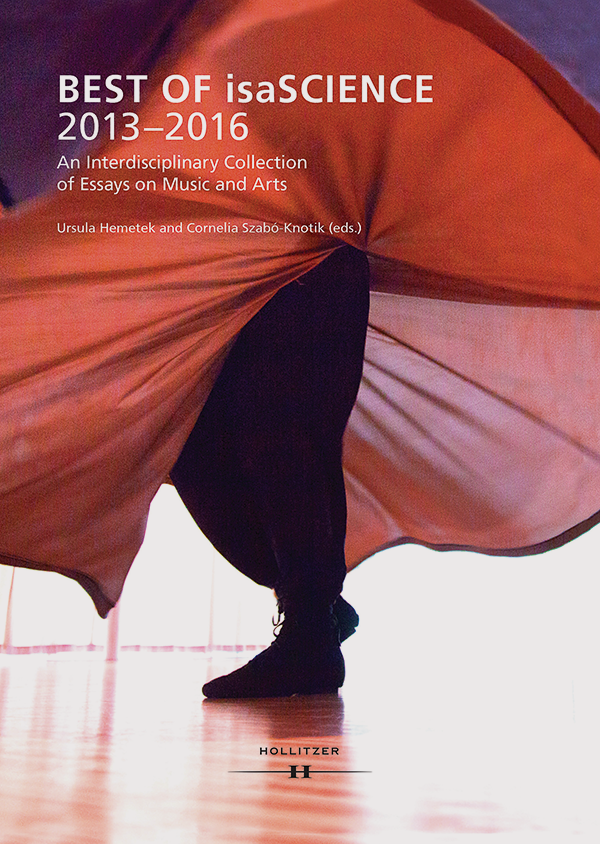Best of isaScience 2013–2016. An Interdisciplinary Collection of Essays on Music and Arts. Ursula Hemetek and CorneliaSzabó-Knotik (eds.) published by Hollitzer, 2017.
 isaScience, a unique initiative of the University of Music and Performing Arts, Vienna, has been bringing together scholars and artists from diverse disciplines since 2013 in order to further current debates in the field of music and performing arts. The increasing significance of this event over the years has resulted into a truly engaging collection of selected essays brought together in three themed sections by editors Ursula Hemetek and Cornelia Szabó-Knotik in the book Best of isaScience 2013–2016.
isaScience, a unique initiative of the University of Music and Performing Arts, Vienna, has been bringing together scholars and artists from diverse disciplines since 2013 in order to further current debates in the field of music and performing arts. The increasing significance of this event over the years has resulted into a truly engaging collection of selected essays brought together in three themed sections by editors Ursula Hemetek and Cornelia Szabó-Knotik in the book Best of isaScience 2013–2016.
The book begins with two keynotes. The first keynote by author Julya Rabinowich focuses on three critical moments in European history while locating herself and artistic work at large as witnesses to the music, motions, images, and words in those moments of upheaval. In conceding the failures, the violent fragmentation of Europe in the 19th and 20th centuries, she finds a sense of cultural integration in the present, where artists from diverse parts of the world can come together to network, find mutual support and go in-depth with creative and intellectual exchange. Rabinowich’s powerful and quite personal essay strikingly sets a foundation of fragments that will shape the years to come. In the second keynote, writer-director Dieter Berner, drawing on his own experiences from the 1960s onward, underlines the return to the mythological in order to assert the significance of transcendental experiences that allow theatre practitioners to develop a particular kind of sensitivity and openness that allows them to go beyond themselves. While emphasizing the irrational, the “ancient magic” in theatre, Dieter Berner nuances the politics of reason while imagining new realms of perception, experience, and performance for the community of artists at large.
The first chapter, “Minorities, Musical Traditions and Power Structures” includes three contributions by Christiane Fennesz- Juhasz, Gerda Lechleitner, and Marko Kölbl. They address a diverse range of issues from the politics of (self)-representation to cultural memory and the role of archives with reference to the Roma and the Burgenland Croats. Given the political history of the EU’s changing borders and Croatia’s EU membership, this chapter very succinctly engages with musical and dance traditions as significant locations of negotiating the hegemonic culture and discourses.
The second chapter, entitled “Music as a Tool of Communication”, includes two group-authored articles. The first, introduced by Elena Fitzthum, deals with rituals and music therapy where the focus is on children (Sandra Lutz Hochreutener), on adolescents (Monika Smetana), and on the ritual of tarantism from southern Italy (Adriano Primadei). Although there is rich material here, this essay lacks flow and struggles to bring out the interconnectedness between the case studies. Laura Bishop and Werner Goebl, in the second article, present an examination of non-verbal signals in ensemble performance involving skilled musicians including an intricate and detailed analysis of the visual cues and strategic bodily gestures that makes clear such signals’ role in communication, co-ordination, conflict resolution, and building trust.
In the third and final chapter, “Music as Cultural Memory and its Rituals”, Ivan Raykoff’s examination of the Eurovision Song Contest as a ritual to build Euro-patriotism, Maria Helfgott’s analyses of old music, and the intriguing stories narrated by Christian Glanz, Anita Mayer-Hirzberger, and Cornelia Szabó-Knotik all serve to represent the vibrant realms of cultural activities in Europe. Zdravko Blažeković, Tatjana Marković, and Leon Stefanija’s eloquent presentation of the historiography of the emerging identities of (post-)Yugoslav music is extremely rich. And most striking is the conversation between Ana Hofman and Rosa Reitsamer in which they analyse heritage and memory in popular music with a focus on activist choirs in post-Yugoslav societies.
Although the focus of this book is limited to Europe, it is indeed a successful endeavour in its commitment to transdisciplinary research and critical dialogue.

